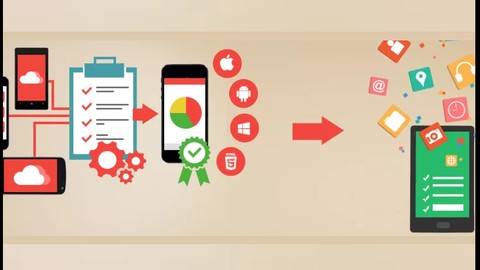
Mobile Application Manual Testing – Android Application
Mobile Application Manual Testing – Android Application, available at $29.99, has an average rating of 2.7, with 40 lectures, based on 57 reviews, and has 314 subscribers.
You will learn about Ready to test android application on real devices or emulators This course is ideal for individuals who are Freshers looking opportunity in Mobile application testing or Manual tester looking opportunity in Mobile app automation It is particularly useful for Freshers looking opportunity in Mobile application testing or Manual tester looking opportunity in Mobile app automation.
Enroll now: Mobile Application Manual Testing – Android Application
Summary
Title: Mobile Application Manual Testing – Android Application
Price: $29.99
Average Rating: 2.7
Number of Lectures: 40
Number of Published Lectures: 19
Number of Curriculum Items: 40
Number of Published Curriculum Objects: 19
Original Price: $19.99
Quality Status: approved
Status: Live
What You Will Learn
- Ready to test android application on real devices or emulators
Who Should Attend
- Freshers looking opportunity in Mobile application testing
- Manual tester looking opportunity in Mobile app automation
Target Audiences
- Freshers looking opportunity in Mobile application testing
- Manual tester looking opportunity in Mobile app automation
Mobile application testing is a process by which developer developed for hand held mobile devices is tested for its functionality, usability and consistency.Mobile application testing can be automated or manual type of testing. Mobile applications either come pre-installed or can be installed from mobile software distribution platforms. Mobile devices have witnessed a phenomenal growth in the past few years. A study conducted by the Yankee Group predicts the generation of $4.2 billion in revenue by 2013 through 7 billion U.S. smartphone app downloads.
This Course going to cover following testing approaches
#1. Hardware testing:
The device including the internal processors, internal hardware, screen sizes, resolution, space or memory, camera, radio, Bluetooth, WIFI etc. This is sometimes referred to as, simple “Mobile Testing”.
#2. Software or Application testing:
The applications that work on mobile devices and their functionality is tested. It is called the “Mobile Application Testing” to differentiate it from the earlier method. Even in the mobile applications, there are few basic differences that are important to understand:
a) Native apps: A native application is created for use on a platform like mobile and tablets.
b) Mobile web apps are server-side apps to access website/s on mobile using different browsers like chrome, Firefox by connecting to a mobile network or wireless network like WIFI.
c) Hybrid apps are combinations of native app and web app. They run on devices or offline and are written using web technologies like HTML5 and CSS.
Course Curriculum
Chapter 1: Indroduction
Lecture 1: What is Mobile Application Testing
Lecture 2: Different types of Applications
Lecture 3: Difference between Real device & Emulators/Simulators
Chapter 2: Bug Reporting in JIRA(When Found any defect in Application)
Lecture 1: Jira Dashboard and Update Profile
Lecture 2: Report new defect to JIRA
Lecture 3: Search defect in JIRA
Lecture 4: Defect life cycle in case of valid defect
Lecture 5: Defect life cycle in case developer rejected defect
Chapter 3: TestCase Writing for any application(Includiing mobile application)
Lecture 1: Standard test case format
Lecture 2: Test Case Id
Lecture 3: Test Case Description
Lecture 4: Pre-requisite or Pre-Condition
Lecture 5: Test Case Steps
Lecture 6: Test Data
Lecture 7: Expected Result
Lecture 8: Actual Result and Status
Lecture 9: Comments
Lecture 10: Priority of Test Case
Lecture 11: Type of Test Case
Instructors
-
Testing World
Director of Testing World
Rating Distribution
- 1 stars: 11 votes
- 2 stars: 8 votes
- 3 stars: 12 votes
- 4 stars: 11 votes
- 5 stars: 15 votes
Frequently Asked Questions
How long do I have access to the course materials?
You can view and review the lecture materials indefinitely, like an on-demand channel.
Can I take my courses with me wherever I go?
Definitely! If you have an internet connection, courses on Udemy are available on any device at any time. If you don’t have an internet connection, some instructors also let their students download course lectures. That’s up to the instructor though, so make sure you get on their good side!
You may also like
- Top 10 Video Editing Courses to Learn in November 2024
- Top 10 Music Production Courses to Learn in November 2024
- Top 10 Animation Courses to Learn in November 2024
- Top 10 Digital Illustration Courses to Learn in November 2024
- Top 10 Renewable Energy Courses to Learn in November 2024
- Top 10 Sustainable Living Courses to Learn in November 2024
- Top 10 Ethical AI Courses to Learn in November 2024
- Top 10 Cybersecurity Fundamentals Courses to Learn in November 2024
- Top 10 Smart Home Technology Courses to Learn in November 2024
- Top 10 Holistic Health Courses to Learn in November 2024
- Top 10 Nutrition And Diet Planning Courses to Learn in November 2024
- Top 10 Yoga Instruction Courses to Learn in November 2024
- Top 10 Stress Management Courses to Learn in November 2024
- Top 10 Mindfulness Meditation Courses to Learn in November 2024
- Top 10 Life Coaching Courses to Learn in November 2024
- Top 10 Career Development Courses to Learn in November 2024
- Top 10 Relationship Building Courses to Learn in November 2024
- Top 10 Parenting Skills Courses to Learn in November 2024
- Top 10 Home Improvement Courses to Learn in November 2024
- Top 10 Gardening Courses to Learn in November 2024





















